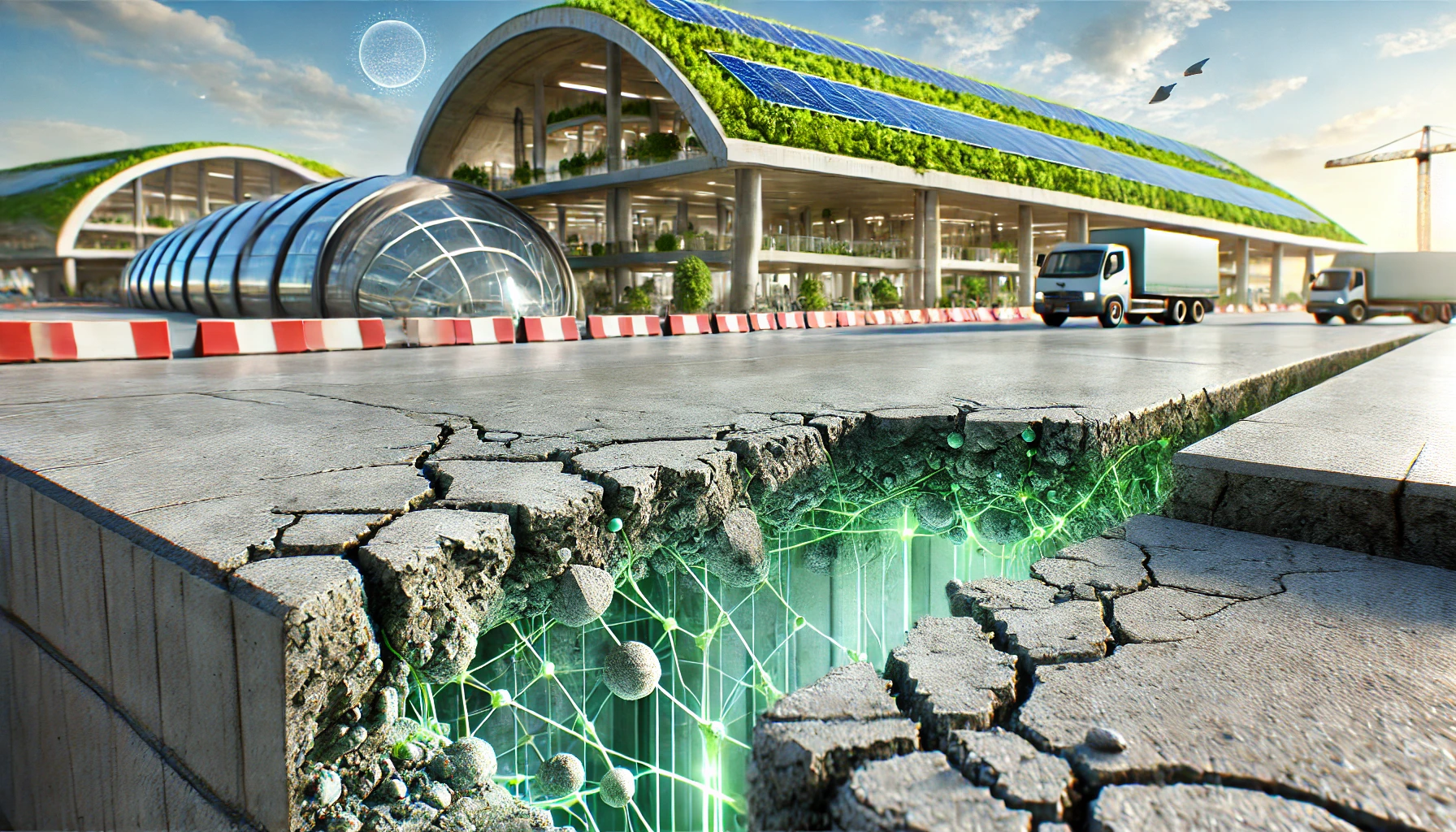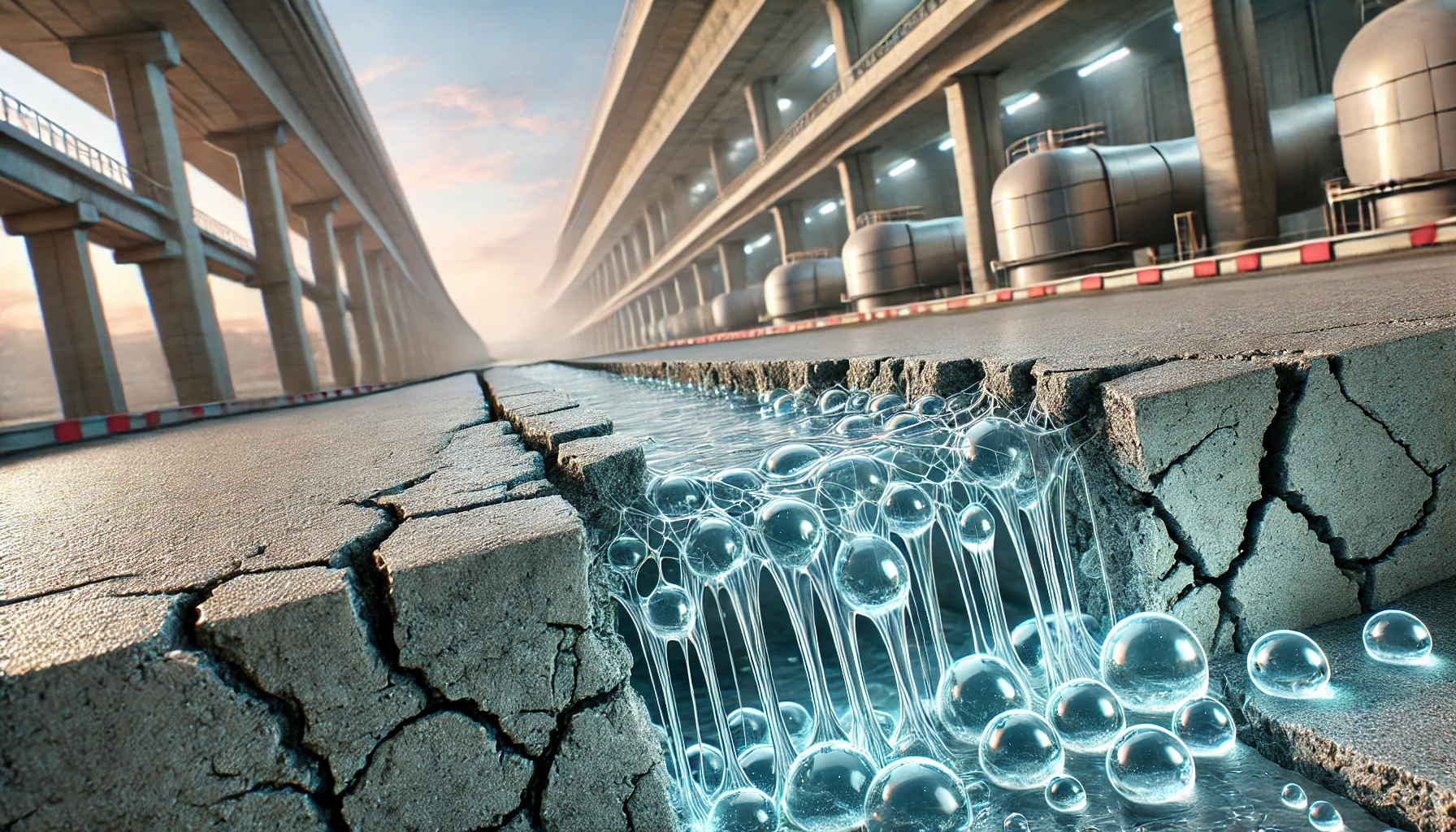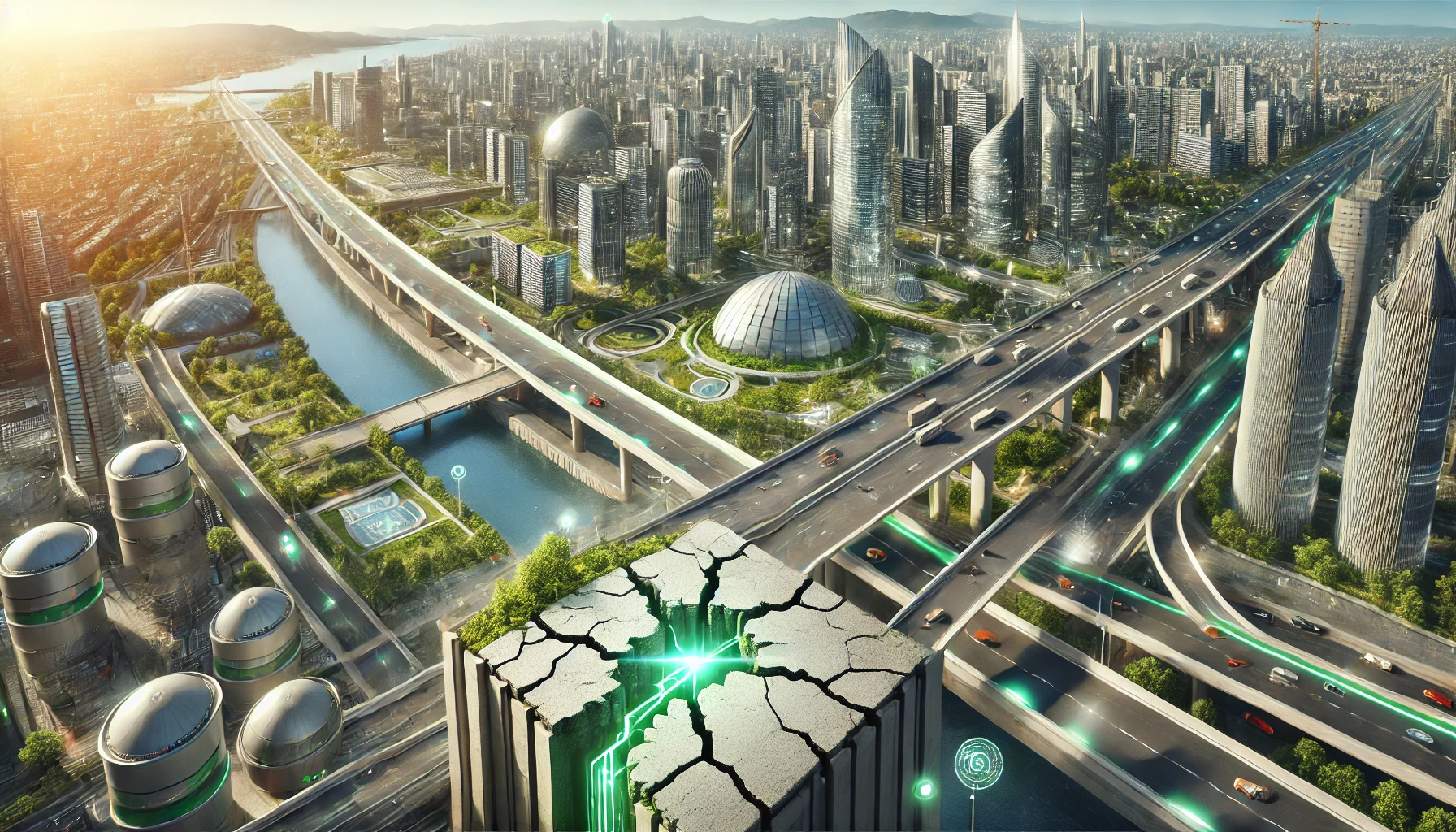
Concrete has long been the backbone of modern construction, forming the basis of structures ranging from towering skyscrapers to highways and bridges. However, concrete structures face a significant challenge: cracked concrete. Cracks naturally form in concrete due to various factors, including stress, temperature changes, and environmental exposure. These cracks, if left untreated, can compromise the structural integrity of buildings, shorten their service life, and lead to costly repairs. Traditional methods of crack repair often involve manual intervention, which is time-consuming and expensive. However, the development of self-healing concrete offers a groundbreaking solution that could revolutionize the construction industry, making structures more durable and sustainable.
What is Self-Healing Concrete?
Self-healing concrete is a type of concrete matrix designed to repair its own cracks automatically over time. This self-healing mechanism is a remarkable advancement in materials science, mimicking nature’s own healing processes to restore damaged concrete structures. The ability of concrete to heal cracks on its own is achieved by integrating healing agents within the concrete mix. These agents activate when cracks form, triggering a chemical reaction that leads to the repair of the crack.
The self-healing process is not only more efficient but also enhances the longevity of the structure, reducing the need for constant maintenance. Researchers have been exploring various methods to develop self-repairing concrete, including the use of bacteria, chemical compounds, and superabsorbent polymers to stimulate healing. The main goal is to create a material that can restore its mechanical properties and maintain structural integrity without external intervention.
The Science Behind Self-Healing Concrete: How It Works
Self-healing concrete isn’t just a theoretical concept but a highly practical solution grounded in chemistry and biology. To understand how this revolutionary material works, we must look at the various healing agents and their roles in repairing cracks. These agents are carefully chosen based on their ability to activate when cracks form, ensuring that the healing process occurs automatically.
Autogenous Self-Healing: Nature’s Blueprint
One of the key mechanisms of self-healing concrete is autogenous healing, where the concrete’s own chemical composition allows it to heal cracks. In this process, the calcium hydroxide (Ca(OH)2) in the cement reacts with water and carbon dioxide (CO2) from the surrounding air. This reaction produces calcium carbonate (CaCO3), a compound that forms crystal-like structures within the crack. Over time, these crystals grow, filling the crack and sealing it. The formation of calcium carbonate not only heals the crack but also improves the concrete’s strength and durability.
Autogenous healing works best for small, narrow cracks that occur in the concrete, typically those less than 0.3 mm in width. However, autogenous healing has limitations in the size of cracks it can address, which is why scientists are increasingly looking at additional methods, such as bacterial healing, to extend its capabilities.
Bacterial Self-Healing: A Biological Solution
One of the most fascinating innovations in self-healing concrete involves the use of bacterial spores embedded in the concrete mix. These bacteria remain dormant until a crack forms and moisture penetrates the surface. When activated by the presence of water, the bacteria begin to metabolize nutrients, producing limestone (calcium carbonate) as a byproduct. This limestone acts as a rock-like material, filling the crack and restoring the integrity of the concrete.
The primary bacteria used in this process are Bacillus species, which are capable of surviving in harsh conditions, including the alkaline environment of concrete. Researchers have discovered that when the bacteria are combined with calcium lactate, the bacteria can produce limestone over time, even under harsh environmental conditions.
How Does Bacterial Healing Benefit Concrete?
-
Durability: Bacteria can remain dormant for extended periods, ensuring that the concrete is continuously able to repair itself as needed.
-
Environmentally Friendly: Bacterial healing reduces the need for chemical additives and non-renewable materials. It is a sustainable solution for long-term maintenance.
-
Cost Efficiency: By reducing the frequency of repairs, bacterial self-healing concrete can save significant amounts of money in long-term infrastructure maintenance.
One such successful application of bacterial healing has been seen in the Delft University research projects, where bacteria-based concrete has been used to repair dams and water-retaining structures. The research at Delft has paved the way for large-scale applications, demonstrating that self-healing concrete can be a viable and reliable solution in civil engineering.
Polymeric Healing Agents: Absorbing Water to Heal

Another approach to self-healing concrete involves the use of superabsorbent polymers (SAPs). These polymers absorb water from the surrounding environment when cracks form and expand within the crack. Once inside the crack, the SAPs turn into a gel-like substance that acts as a filler, sealing the crack and preventing further damage. This method is particularly useful for structures that experience moisture fluctuation or are exposed to significant environmental stresses, such as water-retaining structures like reservoirs or canals.
The major advantage of using SAPs is their ability to absorb large amounts of water. This makes them highly effective in areas with frequent wet and dry cycles, where cracks tend to form due to the expansion and contraction of the material.
Incorporating Healing Compounds into Concrete
In addition to bacteria and polymers, other healing agents such as diatomaceous earth and calcite-producing compounds can be used in self-healing concrete. These compounds are added to the mix during the production of the concrete, where they interact with moisture and trigger the formation of healing products like calcium carbonate. These compounds are beneficial because they don’t just close cracks but also reinforce the overall cementitious matrix, improving the concrete’s resilience and mechanical properties.
For example, diatomaceous earth, which is rich in silica, can react with the hydrated lime in concrete to produce calcium silicate hydrate (C-S-H), a compound that strengthens the concrete’s structure. This reaction can be particularly valuable in harsh environments where traditional concrete may fail due to the constant exposure to moisture and aggressive chemicals.
Supplementary Cementitious Materials (SCMs) and Their Role
SCMs, such as fly ash, slag, and silica fume, are often incorporated into self-healing concrete mixes to enhance their healing capabilities. These materials improve the overall durability of the concrete, reduce its carbon footprint, and provide additional benefits like reducing alkali-silica reaction (ASR), which can cause cracking. Additionally, these materials can contribute to the formation of a more reactive cementitious matrix, further improving the concrete’s ability to self-heal over time.
By combining traditional concrete materials with these supplementary cementitious materials, researchers are able to produce concrete that is both highly durable and capable of self-repair.
Advantages of Using Self-Healing Concrete in Modern Construction
The incorporation of self-healing concrete into the construction industry offers many compelling benefits. Here are a few:
-
Enhanced Durability and Lifespan: Self-healing concrete significantly enhances the lifespan of infrastructure, reducing the need for frequent repairs and extending the service life of structures like roads, bridges, and buildings.
-
Maintenance Reduction: Fewer cracks and defects in concrete mean lower maintenance costs. The automatic healing of cracks reduces the time and labor required for repairs, making it cost-effective in the long run.
-
Increased Structural Integrity: The healing process restores structural integrity, which is especially critical in water-retaining structures, where cracks could lead to serious issues like water leakage or even failure.
-
Eco-Friendly: Self-healing concrete contributes to a more sustainable construction industry by reducing the need for additional repair materials and preserving the environment by using environmentally friendly healing agents.
Real-World Examples of Self-Healing Concrete
There are several notable examples of self-healing concrete being used in real-world applications, providing strong evidence of its effectiveness.
Delft University of Technology (Netherlands)
Delft University of Technology has been at the forefront of research into self-healing concrete. The university has developed a version of self-healing concrete using bacterial spores embedded in the material. These spores become active when moisture infiltrates the concrete, producing calcium carbonate to seal cracks. The project has demonstrated success in real-world conditions, showing that self-healing concrete can perform well over extended periods.
The Netherlands’ Crack-Healing Concrete Road Project
In 2016, a pilot project in the Netherlands involved the construction of a road made with self-healing concrete that used superabsorbent polymers to repair cracks. The cracks that typically form in asphalt roads due to constant wear and tear were automatically repaired, resulting in a longer-lasting road surface with lower maintenance costs.
Concrete for Bridges and Dams in Japan
In Japan, self-healing concrete has been used in the construction of bridges and dams, which are subject to immense stress and environmental exposure. The integration of bacteria-based healing has shown promising results in sealing cracks and reinforcing the structural integrity of these vital infrastructure components. The success of these projects highlights the potential of self-healing concrete to enhance the durability and safety of critical infrastructure.
The Future of Self-Healing Concrete

The potential for self-healing concrete is immense, not only for the construction industry but also for infrastructure projects worldwide. As technology and research continue to advance, we can expect to see more innovative applications of self-healing concrete in the coming years. From reducing environmental impact to enhancing structural durability, self-healing concrete could soon become the standard for construction materials.
With further development, self-healing concrete may play a pivotal role in addressing the global infrastructure crisis, reducing maintenance costs, and contributing to environmentally friendly construction practices. Its integration into civil engineering could also pave the way for more resilient buildings and infrastructures that stand the test of time.
For further information on self-healing concrete and related research, consider exploring the following links:
The Healing Process in Self-Healing Concrete
The key to self-healing concrete lies in its ability to activate a healing process when cracks occur. There are several ways in which concrete can heal itself, each utilizing different healing agents or mechanisms. The most common methods include:
-
Autogenous Healing: This is the most basic form of self-healing, where innate autogenous healing characteristics of concrete come into play. When a crack forms, the unhydrated cement particles in the crack react with moisture from the air or surrounding environment. This leads to the formation of calcium carbonate (CaCO3), which fills the crack and seals the surface.
-
Bacterial Healing: Researchers have discovered that bacteria can be embedded in concrete to aid in the healing process. Limestone-producing bacteria are often used in this method, as they produce calcium carbonate when activated by moisture. The bacteria lie dormant in the concrete until a crack forms, at which point they become active and produce a stone-like material that heals the crack. This process not only repairs the crack but also strengthens the surrounding concrete, ensuring long-term durability.
-
Polymeric Healing: Superabsorbent polymers are another effective healing agent used in self-healing concrete. These polymers absorb water from the surrounding environment when a crack forms, and in doing so, they expand and create a gel-like substance that seals the crack. This method is particularly effective in regions prone to harsh environments where moisture exposure is high.
Benefits of Self-Healing Concrete
The development of self-healing concrete offers numerous benefits for the construction industry, including enhanced durability, reduced maintenance costs, and an environmentally friendly approach to construction. Here are some of the key advantages:
-
Extended Service Life: Self-healing concrete can significantly extend the lifespan of concrete structures by preventing the progression of cracks. This reduces the frequency of repairs and maintenance, ultimately enhancing the overall durability of buildings, bridges, and other infrastructure.
-
Cost-Effective Repairs: Traditional methods of crack repair are expensive and time-consuming, requiring specialized labor and materials. With self-healing concrete, cracks can be repaired automatically, reducing the need for frequent interventions and cutting down on labor costs.
-
Environmentally Friendly: Self-healing concrete is an environmentally friendly solution, as it reduces the need for cementitious materials that contribute to carbon emissions. Some self-healing mechanisms, such as bacterial healing, rely on natural processes that are more sustainable than conventional repair methods.
-
Improved Structural Integrity: By healing cracks as they form, self-healing concrete maintains the structural integrity of buildings over time. This is particularly important for water-retaining structures, such as dams, canals, and sewage systems, where the presence of cracks can lead to water leakage and other issues.
-
Reduced Maintenance: Structures made with self-healing concrete require less frequent inspection and repair. This is particularly beneficial in areas where regular maintenance is difficult or costly due to factors like negative pressure forces, weather conditions, or difficult access.
Self-Healing Concrete Applications
Self-healing concrete has a wide range of applications across various construction sectors. It has shown significant potential in projects involving water retaining structures, civil engineering, and highway construction. Some notable examples include:
-
Bridges: Bridges are constantly subjected to stress, temperature changes, and environmental wear, making them prone to cracks. Self-healing concrete can help ensure that bridges remain structurally sound for a longer period, reducing the need for costly repairs and extending their lifespan.
-
Highways and Pavements: Roads and highways are subjected to heavy traffic loads, which can lead to cracks and surface damage. By incorporating self-healing concrete into pavement construction, the lifespan of roads can be extended, resulting in fewer potholes and cracks.
-
Buildings: In high-rise buildings and residential structures, self-healing concrete can improve the longevity and durability of the foundation and walls, reducing the need for repairs and increasing the overall sustainability of the building.
-
Dams and Water Retaining Structures: Cracks in dams and water reservoirs can cause significant damage and lead to catastrophic failure. Using self-healing concrete for such structures can help mitigate these risks by automatically sealing cracks and preventing leakage.
Key Components of Self-Healing Concrete
Self-healing concrete is typically composed of several essential components, each playing a crucial role in the healing mechanism:
-
Healing Agents: These are the substances that activate the healing process when cracks form. Examples include bacteria, calcium lactate, superabsorbent polymers, and other compounds that promote the formation of calcium carbonate or other healing products.
-
Cementitious Matrix: The cementitious material forms the basic structure of concrete. This matrix provides the necessary support for the healing agents, ensuring that they remain effective over time. The matrix also contains unhydrated cement particles that contribute to autogenous healing.
-
Supplementary Cementitious Materials (SCMs): Materials like fly ash, slag, and silica fume can be added to the mix to improve the mechanical properties of the concrete and support the self-healing process. These materials enhance the durability and workability of the concrete while reducing environmental impact.
-
Bacterial Spores: In bacterial healing systems, bacterial spores are incorporated into the concrete mix. These spores remain dormant until cracks form, at which point they are activated by moisture and begin producing calcium carbonate to seal the crack.
-
Water Absorption Compounds: Some forms of self-healing concrete rely on compounds that absorb water when cracks appear. These compounds, such as superabsorbent polymers, help maintain moisture levels within the concrete and trigger the healing process.
Challenges and Future Directions
While self-healing concrete shows immense potential, there are still several challenges that need to be addressed before it can be widely adopted:
-
Cost of Production: The production of self-healing concrete is currently more expensive than regular concrete due to the incorporation of specialized materials and healing agents. However, as research advances and economies of scale come into play, these costs are expected to decrease.
-
Long-Term Effectiveness: While self-healing concrete has proven effective in laboratory tests, its long-term performance under real-world conditions needs further study. Researchers are working to better understand how different healing agents perform over time and in various environmental conditions.
-
Regulatory Approval: For widespread adoption, self-healing concrete must be approved by construction and civil engineering regulatory bodies. This involves rigorous testing to ensure that the material meets safety and performance standards.
-
Environmental Impact: Although self-healing concrete is generally considered more sustainable than traditional methods, researchers are working to further optimize its environmental benefits. This includes reducing the carbon footprint of the materials used and enhancing the healing agents’ effectiveness.
Conclusion: The Future of Self-Healing Concrete

Self-healing concrete represents a major breakthrough in the field of construction materials. By integrating healing agents into the concrete matrix, we can reduce the need for manual repairs, extend the lifespan of structures, and contribute to more sustainable construction practices. As research continues and the technology advances, self-healing concrete has the potential to transform the way we build, offering a future of more durable, cost-effective, and environmentally friendly buildings and infrastructure.
For more information on self-healing concrete, check out these resources:
-
The National Concrete Consortium
By incorporating innovative materials and techniques into construction practices, we are moving toward a future where self-healing is a common characteristic of building materials. This shift not only improves the durability of structures but also helps reduce the environmental footprint of construction.
